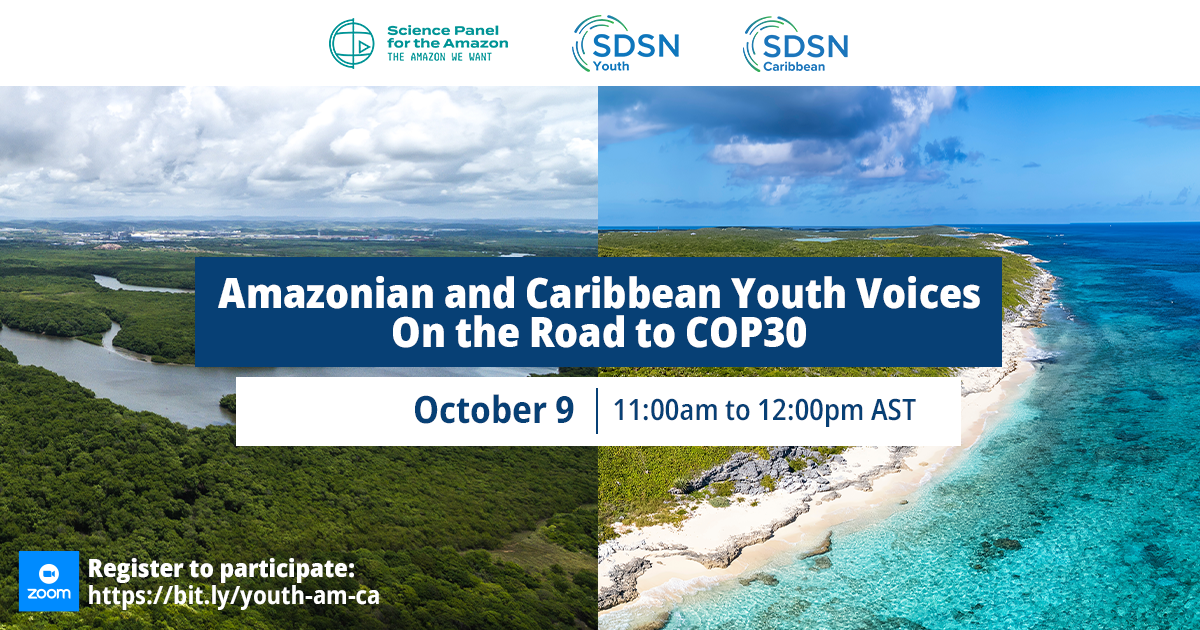The SPA, SDSN Caribbean, and SDSN Youth Host Webinar Featuring Amazonian & Caribbean Youth Voices Ahead of COP30
Written By: Jing-Yi Sutherland, Networks Program Intern
On October 9, 2025, the Science Panel for the Amazon (SPA), SDSN Caribbean, and SDSN Youth hosted a webinar ahead of the 30th Conference of the Parties (COP30), connecting young leaders from the Amazon and Caribbean to discuss climate justice, regional solutions, and COP30 priorities. The event brought together diverse perspectives on how youth, science, and policy can work in tandem to accelerate global climate policies.
The session began with opening remarks by SPA Program Manager Julie Topf, who introduced several key initiatives of the participating programs. She highlighted the SPA’s recent initiatives, including the launch of the Massive Open Online Course (MOOC) “The Living Amazon” and the Youth Advisory Committee (YAC), which aims to provide support to youth engagement in science and policy for the conservation and sustainable development of the Amazon.
The webinar featured three dynamic young leaders from the Caribbean and Amazon regions:
Dorain Clarke, Founder of Youth Climate Voice Caribbean (Jamaica)
Maryane Andrade, Member of the SPA Youth Advisory Committee (Brazil)
Suphane Dash-Alleyne, National Coordinator, Caribbean Youth Environment Network (Guyana)
Together, they reflected on the climate action they hope to see at COP30, the support young people need from governments and organizations, and the ways creativity and cultural knowledge can strengthen community-based climate action.
Youth Priorities for COP30
Opening the discussion, Clarke called for COP30 to make climate finance fast, fair, and fit for purpose. “Finance must be accessible and local,” she said, stressing that resources must reach communities directly to make a real impact. She emphasized the importance of a 50/50 balance between adaptation and mitigation and of setting clear, measurable goals that support youth-led climate initiatives.
Andrade highlighted the necessity of cross-sector partnerships, stressing that “it’s impossible to find a solution on your own.” She urged that youth not be treated as symbolic participants but as essential contributors who bring creativity and innovation to the table. “If young people have a seat at the table,” she added, “we can make a real difference in our communities.”
Dash-Alleyne reflected on the power of mobilization, citing successful environmental demonstrations that have influenced government attention in the Caribbean. She emphasized the role of innovative technologies and community engagement in advancing adaptation strategies, noting that “many young people are already working within environmental and ministerial spaces–what we need is greater coordination and support.”
Capacity Building and Opportunity Areas
When asked about what support is missing from governments and institutions, the panelists pointed to the lack of accessible, sustained opportunities for youth engagement in climate action.
Andrade highlighted the challenge of maintaining stable employment while working on environmental causes: “Many of us are doing climate work on a voluntary basis,” she said. “There needs to be more paid positions for youth in this field.”
Dash-Alleyne underscored the need for long-term capacity-building, suggesting structured programs focused on skills training, improved financial support for education, and youth accessibility. “We need to go to those who can help break down these barriers and fund opportunities for young people,” she added.
Clarke proposed a more systemic approach: embedding youth advisory committees into law to ensure that youth participation is not only symbolic but also a showing of proof that young people are true, impactful change-makers. “We don’t want to be invited to the table. We want our ideas to be implemented,” she said.
Creativity and Indigenous Knowledge in Climate Action
In a later segment, the discussion turned to creative and community engagement as key drivers of climate action.
Clarke proposed the creation of a Community Innovation Lab, a space for youth to prototype low-cost solutions and showcase their projects and research.
Dash-Alleyne emphasized that some of the most innovative conservation strategies come from Indigenous and Local Knowledge systems. She called for more platforms where youth and Indigenous communities can collaborate, share, and showcase their work, emphasizing the role of storytelling and creative media in mobilizing action.
Collaborative Momentum and Next Steps
The session concluded with a Q&A, as participants engaged directly with the panelists. Topf reaffirmed SDSN’s commitment to empowering youth leadership in climate action.
The discussion showcased how partnership, creativity, and cultural knowledge are at the heart of Amazonian and Caribbean climate resilience. By integrating youth perspectives into governance and policy, the region can build a more inclusive, sustainable, and equitable future. One that ensures the voices of young people are not only heard, but truly shape the path forward to COP30 and beyond.
Re-watch the webinar on the SDSN’s YouTube channel, and learn more about the Science Panel for the Amazon, SDSN Caribbean, and SDSN Youth.
Explore the COP30 Resource Hub to explore key issues, the SDSN’s calls for action, events, and relevant resources.

